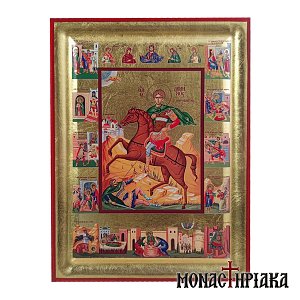The Church of Saint Demetrios in Thessaloniki - UNESCO World Heritage Site
The Holy Church of Saint Demetrios in Thessaloniki is located at the center of the city, above the ancient Roman Agora. Since 1988, the Temple has been included in the UNESCO World Heritage Sites and is the most important early Christian monument in the city.
What did the excavations reveal?
As evidenced by the excavations, the Church of Saint Demetrios is built in a place where the public baths operated during the Roman period.
According to the tradition, Saint Demetrios was imprisoned and martyred with a spear, in this exact place.


Later, in the year 313 AD after the Edict of Milan, a small church was built over the Saint's tomb.
Many believers flocked to this small church to worship the Saint's tomb and pray for healing from serious illnesses.
Among the pilgrims was the eparch of Illyricum Leontius. He himself was cured of a serious illness and in order to show his gratitude, he built a magnificent Church in honor of Saint Demetrios, on the spot where the small church had been until recently.
In the imposing temple, which was completed in the 5th century, the tomb of the Saint Demetrios was also moved, inside a ciborium in the middle aisle. Today, this crypt is in the north aisle.


In the year 620 AD a great earthquake destroyed the temple, and it was rebuilt in the 7th century, according to the model of the original temple. The Church of Saint Demetrios continued to radiate and attract multitude of believers throughout the Byzantine period.
The period of Turkish rule
During the Turkish occupation, from 1493 when Thessaloniki was conquered by the Turks, the Church of Saint Demetrios was converted into a mosque with the name Kasimiye Camii.
At that time, Christian worship was limited to a small area, where the cenotaph of the Saint was created.
The full operation of the Church returned to the faithful in 1912 with the liberation of Thessaloniki.

The Architecture of the Temple
The Holy Church of Saint Dimitrios architecturally has the type of the pentacle Basilica. The nine mosaic paintings, as well as the offerings (tama) are of special historical and aesthetic value. They date from the 6th and 7th centuries and are located on the columns (pessos) of the Holy Step.


The Crypt and the galleries under the Temple: the place where Saint Demetrios was imprisoned and martyred
A whole complex of arcades with corridors and strong pillars is located under the Sanctuary of today's Church of Saint Demetrios.
During Roman times, this space was on the ground floor and was the bathhouse. Later, a fountain with five niches and arcades was formed.
After the foundation of the first great Temple in the 5th century, the faithful honored Saint Demetrios through the holy water that flowed in the fountain from a water well that is still preserved today, on the northern side of the Sanctuary.
In addition, in the Crypt we find a Chapel with an opening on the east side, which was originally connected to the fountain and the Sanctuary of the Temple. This exact spot is considered the place where Saint Demetrios Myrovlytis was martyred.




Here you can find icons of Saint Demetrios Myrovlitis.
In modern history, the Crypt came to light in 1917 after the devastating fire that leveled the city of Thessaloniki. Extensive restoration and maintenance work highlighted the catacombs and the importance of the site. In 1988, the gates were officially opened to the public in the form of a museum exhibition.
Today, in the area of the Crypt, various objects are displayed in which the faithful kept the myrrh, such as vases, clay, metal and glass containers. In addition, in some places we find traces of frescoes, sculptures and inscriptions, which date back to the 5th century.

The Chapel of the tomb of Saint Dimitrios and Saint Euthymios
In the area of the church, there is also the chapel of the tomb of Saint Dimitrios. The tomb was originally located under the Holy Altar in the Sanctuary. However, probably for practical reasons, the Saint's tomb was moved to that spot to facilitate the faithful who wanted to worship the tomb, during the period of the Turkish occupation.


At the same time, to the right of the Sanctuary we find the chapel of Saint Euthymios, which dates back to the 13th century.
The frescoes that adorn the chapel are characteristic. According to evidence, the frescoes belong to the well-known iconographer Manuel Panselinos from Thessaloniki.
These frescoes show remarkable similarities with the frescoes that we find in the Protatus of the Karyes of Mount Athos, which were created by Panselinos in the period from 1282 to 1328.
Here you can read about the life of Saint Demetrios.


Dismissal Hymn of St Demetrios the Great Martyr
The whole world has found you as a mighty champion in dangers, O victor, who rout the nations. Therefore as you destroyed the pride of Lyaios in the stadium by giving Nestor courage, holy great Martyr Demetrios, implore Christ God to grant us his great mercy
Ἀπολυτίκιον
Μέγαν εὕρατο ἐv τοῖς κιvδύvοις, σὲ ὑπέρμαχοv, ἡ οἰκουμένη, Ἀθλοφόρε τὰ ἔθνη τροπούμενον. Ὡς οὖν Λυαίου καθεῖλες τὴν ἔπαρσιν, ἐν τῷ σταδίῳ θαῤῥύvας τὸν Νέστορα, οὕτως Ἅγιε, Μεγαλομάρτυς Δημήτριε, Χριστὸν τὸν Θεὸν ἱκέτευε, δωρήσασθαι ἡμῖν τὸ μέγα ἔλεος.
















